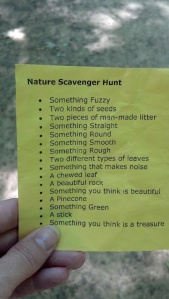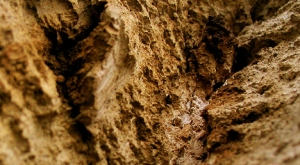Science in Nature
What does it look like when an elementary school classroom takes their scientific study outside? The type of activities that teachers can do will vary greatly depending on the needs of their students. A Kindergarten class will have a very different experience than the 5th grade crew. But no matter the age each classroom can benefit from time spent learning in our garden.
Scavenger Hunts
If students are still developing their reading skills a photographic scavenger hunt could be just the thing.
A parent volunteer or the teacher can take a few moments to walk the garden with a camera in hand. Take detailed photographs of a variety of items, print them out and affix them to recycled egg cartons. Either working in teams or individually students then spend time in the garden hunting and filling their cartons with the items on their list.
Older scientists can be given a more open ended list of items to hunt for that has been customized to fit our natural space. How interesting to compare the last item later on, just what do your students treasure?
Careful Observations
Create a Sound Map with your class. Take students outside and allow each to find their own space. The students mark their location on a blank sheet of paper and then listen quietly in the garden. When they hear something, be it a bird, animal or man, they can mark it on their map. Developing good listening skills will go a long way towards improving classroom skills!
Nature walk observation sheets offer students an opportunity to reflect on what they’ve seen, heard, and felt during their time in the garden. Often we rush through the day giving little thought to observing what’s going on around us. Offer your students time to slow down and really observe the world around them and then share those observations with their peers, there is beauty in the details!
Bird Study
There are a variety of ways to upcycle otherwise discarded materials into natural bird feeders.
Give students an opportunity to create natural bird feeders to attract native birds to our space then take them back out to see if we have any new visitors to our garden. Provide a list of native birds to each scientist and they can check off the birds they see and make observations about behavior. The Audubon Society is a great resource to see what we might expect to find flying around our garden. If we’re really lucky we may even find that some birds would like to nest in our garden and be able to observe-from a safe distance-the hatching of baby birds.
Scientific Experiments
If you dig in our garden for only a few seconds you’re sure to find a lot of WORMS! This made for some interesting conversations at the Garden Clean up with some of our younger helpers. Worms are an important part of our garden’s ecosystem. They help to increase the amount of air and water that are in our soil as well as break down organic matter and, well, fertilize in their own special way! These vital garden assistants can also be the star of their own science experiment, Can Worms Smell? Working in teams or small groups students can set up a test for our garden VIPs to see if they gravitate toward or avoid certain scents. They can make a hypothesis, run the test and analyze the data in real time.
Erosion studies can also be done out in the garden with a minimum of additional materials and supplies. Working in teams scientists can create landscapes out of various types of soil including potting soil or sand. By “planting” trees with sticks, branches and other leafy material before and after the rains come, via a watering can, students can see the real time effect trees, shrubs and grass have on soil erosion.
Indoor/Outdoor Science Experiments
The Growing Sock offers scientists an opportunity to see what sort of secrets are waiting to sprout in the garden. Put an old sock on outside of your shoe and go for a walk out in the garden. Remove the sock and give it a good dousing of water from a spray bottle before depositing it into a plastic bag, labeled with the scientist’s name and tape the bag to a window in the classroom. Check and observe the growth of your experiment, make observations, notes, and drawings about what is happening. After a few weeks scientists should see a very different landscape in their bag!
 Learning how plants grow and learning to label the different parts of the process and the plant can be fun for young scientists. Many students have never had an opportunity to watch something grow from seed to finished plant, after all the Chia Pet isn’t as popular as it was when we parents were young! This experiment offers a quick and easy way for scientists to see the process up close. Using clear CD cases allows for easy storage as well as easy access to watering the growing plant but this experiment can also be done in clear plastic bags. The Green Education Foundation also has clear step by step instructions and supporting materials for this experiment.
Learning how plants grow and learning to label the different parts of the process and the plant can be fun for young scientists. Many students have never had an opportunity to watch something grow from seed to finished plant, after all the Chia Pet isn’t as popular as it was when we parents were young! This experiment offers a quick and easy way for scientists to see the process up close. Using clear CD cases allows for easy storage as well as easy access to watering the growing plant but this experiment can also be done in clear plastic bags. The Green Education Foundation also has clear step by step instructions and supporting materials for this experiment.
There are literally thousands of websites offering suggestions on how to take learning outside. But remember, it does not have to be an elaborate experiment to be effective. Just the simple act of changing the physical environment can spark learning in surprising ways. Time spent teaching outdoors is time well spent!






















